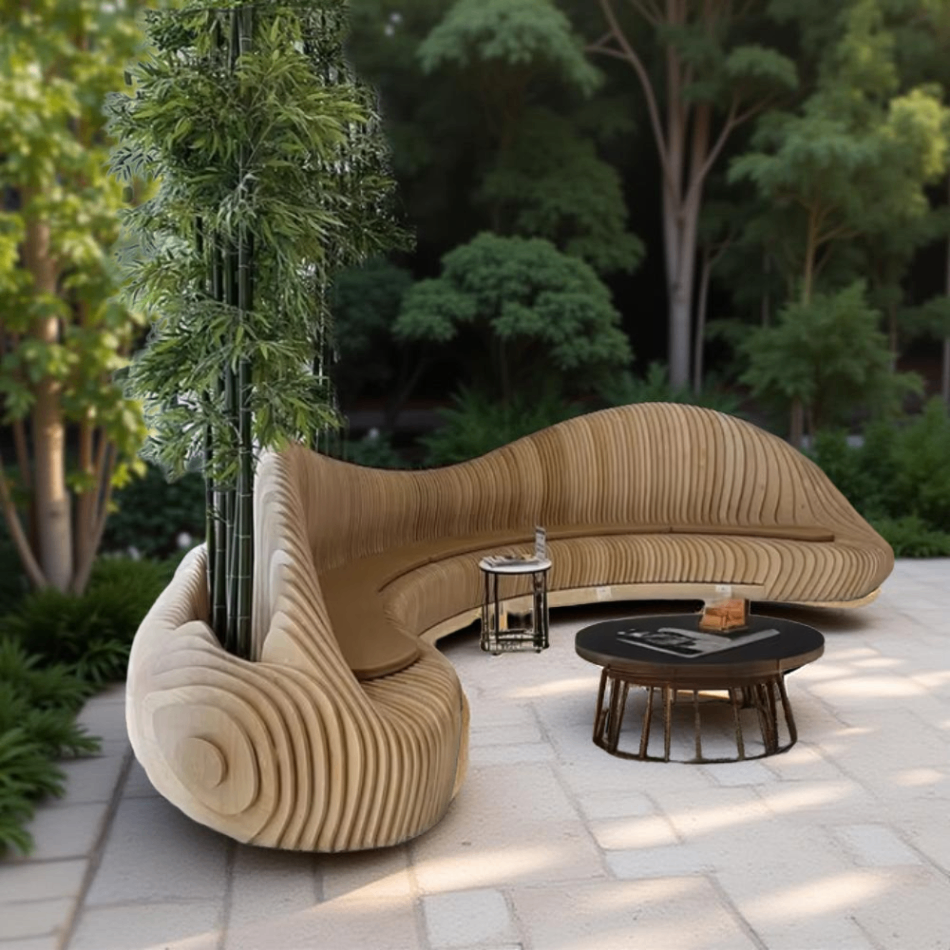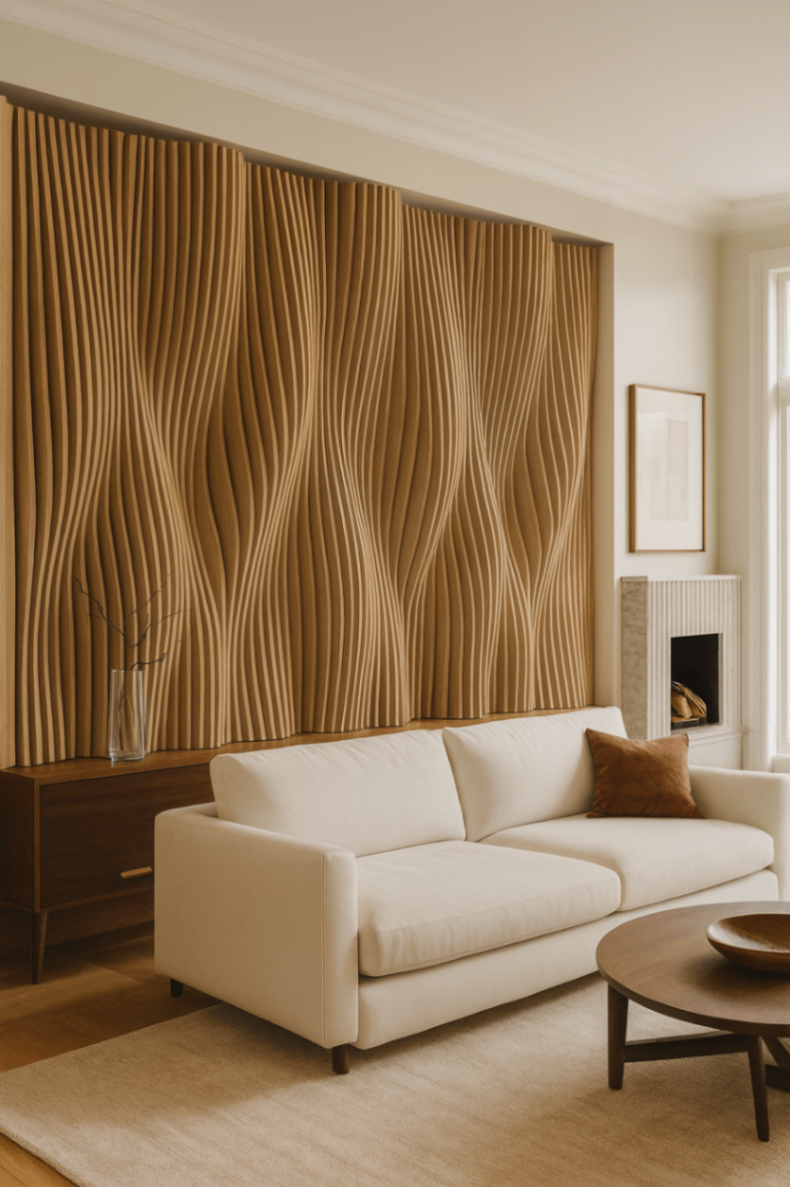Outdoor Wood Bench Trends 2025–2026: Parametric Design, Smart Materials & Expert Insights
- alyez0
- Nov 13
- 6 min read

In 2025, the humble outdoor wood bench is no longer just a place to sit. It’s becoming a sculptural object, a piece of micro-architecture that reflects new thinking in landscape design, sustainability, and digital fabrication. Parametric design — with its flowing curves and algorithm-driven forms — is at the heart of this shift. Zorka Furniture+1
Whether you’re a landscape architect, interior designer, or homeowner planning a modern patio, understanding how parametric design and new materials are reshaping the outdoor wood bench will help you make better, longer-lasting choices.
What Is a Parametric Outdoor Wood Bench?
In simple terms, parametric design uses algorithms and adjustable parameters (dimensions, curves, density of elements) to generate complex forms that would be difficult to design by hand. In furniture and outdoor seating, this often means:
Layered profiles cut from wood and stacked into flowing, ergonomic shapes
Benches that look like a continuous ribbon or landscape topography
Forms that respond to site constraints: slope, views, circulation paths, or existing trees BeeGraphy Platform | beegraphy.com+1
International studios like Zaha Hadid Architects and MARC FORNES / THEVERYMANY have helped popularize this language of fluid, organic geometry through their pavilions and seating pieces, inspiring a new generation of designers to reimagine benches as sculptural, experiential objects rather than simple planks on legs. Archello+2ArchDaily+2
For outdoor spaces, a parametric outdoor wood bench can:
Guide movement and frame views
Create social “pockets” and gathering points
Become a recognizable landmark within a park, hotel, or public plaza
Why Parametric Benches Fit Today’s Landscape & Outdoor Living Trends

Recent landscape architecture and garden design trends emphasize natural, resilient, and sustainable environments: reclaimed materials, planted borders, and seating that feels integrated with the terrain rather than placed on top of it. Ashwell Timber+1
At the same time, outdoor living is being curated as carefully as interior spaces. Homeowners and hospitality brands are embracing:
Minimalism with organic forms — clean silhouettes combined with soft curves and sculptural details Furniture Leisure+1
Bold color accents against natural wood, echoing broader garden trends where vibrant yellows, greens, and terracotta tones are replacing neutral black and grey furniture. Ideal Home+1
Eclectic, layered “outdoor rooms” with multiple seating zones, side tables, planters, and lighting — sometimes including console tables, loungers, and multifunctional benches that adapt to different activities. Yardzen+2The Times+2
A parametric outdoor wood bench fits perfectly into this context. Its flowing geometry can echo surrounding planting, water features, or architectural lines, making the bench feel like a natural extension of the landscape design rather than a separate object.
Materials for Modern Outdoor Wood Benches
Beautiful geometry alone isn’t enough — the success of a parametric bench outdoors depends heavily on material choices and detailing.
1. Solid & Engineered Woods for Exterior Use
Common species for an outdoor wood bench include:
Acacia – dense, naturally resistant to moisture, rot, and insects, often used in convertible outdoor furniture. Southern Living
Teak, ipe, and other hardwoods – classic high-end choices for severe climates and heavy use.
Thermally modified or acetylated woods (e.g., Accoya) – chemically or thermally treated to resist warping, rot, and insects while maintaining a natural wood appearance, increasingly popular in urban seating and landscape projects. Accoya Wood
Engineered options like laminated or layered birch/oak plywood are frequently used in parametric benches, where multiple CNC-cut profiles are stacked into complex forms. For outdoor use, these must be specified in exterior-grade or marine-grade variants, often combined with high-performance coatings.
2. Finishes: Protecting the Geometry
A high-quality outdoor wood bench relies on the right finishing system just as much as on the core timber:
Natural oils (linseed, tung, or hybrid oils) bring out the grain and are easy to refresh, ideal for warm, tactile outdoor benches.
Polyurethane, marine varnish, or high-build outdoor lacquers add a tougher, more UV-resistant shell suitable for high-traffic public spaces.
Pigmented stains or opaque paints make it possible to align the bench color with brand identity or current garden color trends (mustard yellow, deep greens, terracotta reds). Ideal Home+1
Industry guidance emphasizes that well-treated timber benches can maintain their appearance with minimal maintenance — often just annual cleaning and resealing — while offering a more sustainable, repairable option than many synthetic materials.
Key Design Trends in Outdoor Wood Benches

1. Sculptural & Minimal at the Same Time
Modern park and plaza benches increasingly combine:
stripped-back, minimal construction
bold, sculptural gestures — cantilevered edges, sweeping curves, or ribbon-like forms.
Articles on bench design trends note a move toward clean lines, geometric forms, and fewer decorative elements — letting the form and material speak for themselves. Furniture Leisure+1
Parametric benches sit exactly at this intersection: the structure is visually dynamic, yet often built from repeated, simple elements.
2. Color + Natural Texture
Contemporary outdoor spaces are embracing color, from vibrant benches in public gardens to statement pieces on private patios. Recent coverage of garden furniture trends highlights bright yellows, greens, and reds as key tones for 2025, usually balanced with greenery and neutral hardscape. Ideal Home+1
For a parametric outdoor wood bench, there are three successful strategies:
Fully natural: oiled or clear-coated wood for calm, Scandinavian-inspired terraces.
Two-tone: a natural wood body with painted edges or accent ribs.
Full color: solid color to tie into a brand palette or wayfinding strategy in a large park or campus.
3. Multifunctionality & Flexibility
Another visible trend is the rise of transforming and multifunctional outdoor furniture — benches that convert into dining sets, incorporate storage, or double as planters and low tables. Southern Living+1
Parametric benches can integrate:
different seat heights for kids and adults
integrated side tables or laptop surfaces
planters and lighting niches carved directly into the form
This makes a single outdoor wood bench a complete micro-environment for working, relaxing, or socializing.
4. Integrated Lighting & Smart Features
Although more common in metal and composite installations, parametric design from studios like MARC FORNES / THEVERYMANY shows how perforations, lighting, and geometry can work together to create immersive night-time experiences. ArchDaily+1
Translating that thinking to wood benches, designers are starting to add:
LED strips hidden under overhangs or inside gaps between layers
Inductive charging pads or discreet power outlets for laptops and phones
Motion-activated lighting or sound for playful, interactive public seating
What the Experts Are Saying
While every designer has their own approach, several consistent themes appear across statements by leading architects and landscape designers:
Bench as micro-landscape: Zaha Hadid’s Serac Bench for Lab23, made from a durable resin-quartz composite, was conceived almost like a slice of glacier topography — a continuous, carved form rather than a traditional seat. This idea of the bench as a piece of terrain has strongly influenced parametric bench design.

Structure as experience: Marc Fornes’s pavilions, such as The Orb in Mountain View and PILOTI in Bellevue, use ultra-thin, perforated surfaces and computational design to create enveloping structures where light, shadow, and curvature shape how people move and rest. ArchDaily+1
Sustainability + durability: Landscape architecture articles increasingly stress that outdoor furniture must be both resilient and natural, using certified timber, reclaimed wood, or advanced modified woods that withstand weather while aging gracefully. Ashwell Timber+2Accoya Wood+2
Applied to an outdoor wood bench, these expert perspectives push designers to think beyond “a place to sit” and toward objects that:
interact with light and environment
invite touch and exploration
maintain performance over many seasons
How to Choose the Right Outdoor Wood Bench for Your Project
When specifying or commissioning a parametric outdoor wood bench, consider:
Context & Function
Is it for a quiet residential garden, a hotel rooftop, or a busy university campus?
Do you need intimate seating for a few people or a long, continuous bench for crowds?
Material Strategy
Choose species or engineered wood matched to your climate and exposure (sun, coastal conditions, freeze–thaw cycles).
Decide between natural, stained, or painted finishes based on maintenance resources and desired aesthetics.
Parametric Geometry
Use parametric tools to adapt the bench length, curvature, and height to your site.
Explore variations — tighter curves where you want individual seating, more open gestures where you want lounging or lying down.
User Comfort & Accessibility
Provide ergonomic seat heights and back support segments for longer stays.
Include accessible zones and clear circulation around the bench.
Customization & Branding
Align color and geometry with the project’s overall identity.
Consider inlays, engraved patterns, or lighting details that make the bench unmistakably “yours.”
Conclusion: The Future of the Outdoor Wood Bench
The outdoor wood bench has evolved from a purely functional object into a powerful design tool. Parametric design lets you sculpt forms that respond to your site and users, while modern timber technologies and finishes ensure durability and low maintenance.
For designers and clients who want outdoor spaces that feel contemporary, sustainable, and truly memorable, the parametric outdoor wood bench is one of the most effective ways to combine architecture, craftsmanship, and everyday comfort in a single piece of furniture.




Comments